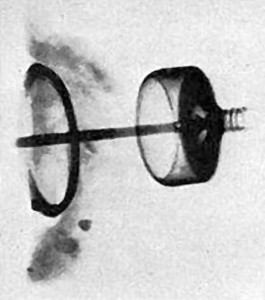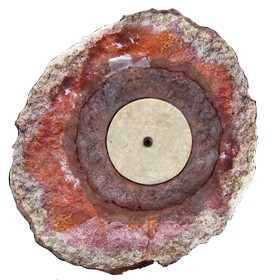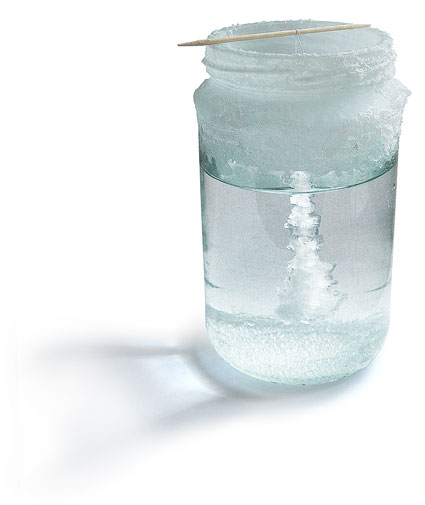500 Million Year Old Spark Plug?
The Coso Artefact
The Coso Artefact

The Coso‘Spark plug’ is one of the most interesting and anomalous artifacts ever discovered.
Its story begins one February morning in 1961, when the owners of a gem shop were out looking for new exhibits in the Coso Mountains of Eastern California. Little did they know that, among the geodes they collected was a controversial relic that would challenge what we knew about our planet’s past.
The next day, they started cutting into the rocks, hoping they contained valuable crystals inside. Instead, they discovered that one of the geodes contained what appeared to be a mechanical device resembling a spark plug.
The device itself consisted of a porcelain cylinder circled by rings of copper. X-ray-analysis showed a magnetic rod and a metal spring were housed inside the cylinder. The rock also contained a soft, white substance that was never identified.

But the most puzzling aspect of this find was the age of the geode, which was determined by analyzing the stratum in which it was found as well as the presence of a concretion of marine animal fossils on its surface. Geologists determined it could be as old as 500,000 years.
All evidence seemed to suggest the Coso artifact and the white substance covering it had spent a long time submerged under seawater. But what civilization had been advanced enough to engineer and then lose it? Was it even an earthly civilization? Turning to mainstream science for answers would be in vain.

Adepts of creationism have cited this oopart (out of place artifact) as evidence for the existence of an advanced pre-flood civilization while atheists have always dismissed it as a hoax.
Unfortunately, this disputed relic was not subjected to rigorous testing and there’s little chance it will ever become the central point of unbiased scientific analysis. It simply vanished in 1969 and hasn’t turned up ever since.
The Coso artifact and other equally-intriguing ooparts will silently fuel conspiracy theories from the obscure comfort as a centerpiece in someone’s private collection.
The 10 Most Not-So-Puzzling Ancient Artifacts: The Coso Artifact
The next
item on the 10 Most Puzzling Ancient Artifacts list is the Coso
Artifact…or
as it should be more correctly named; The 1920’s era Spark Plug that got
confused for a Geode. Which if you know anything about how metal corrodes,
debunks this entirely. It also takes all the fun out of writing a big’ol blog
post about this, so let’s start at the beginning shall we?

Radiograph of the Coso Artifact
In February of
1961, Wallace Lane, Virginia Maxey and Mike Mikesell, who were looking for
minerals to sell in their shop in Olancha, California discovered a
specimen that looked rather different than their normal
fair. The outer layer of the specimen was encrusted with fossil shells and
their fragments. In addition to shells, the discoverers noticed two nonmagnetic
metallic objects in the crust, resembling a nail and a washer.
The next
day, in his workshop at their store, Mike Mikesell claims to have ruined a
nearly new diamond saw blade while cutting the specimen in half. Inside
Mikesell discovered a perfectly circular section of very hard, white material
that appeared to be porcelain. In the center of the porcelain cylinder was a
2-millimeter shaft of bright metal which responded to a
magnet. There are the only hard facts we have on the origin of the
Artifact. Beyond this, things start to get hazy, and red flags begin to pop up.
We don’t
know what all was done to examine the Artifact early on. We know
that Virginia Maxey claims that she took the “geode” to a geologist who
dated the artifact to be about 500,000 years old. We don’t know who this
geologist is, what he did to examine the Artifact, what his real conclusions
were, or if he really existed. Whoever he is, I question his expertise,
because this is object is obviously not a geode.

You can see the concretions growth around the spark-plug.
Remember the
Klerksdorp Spheres that
I went over in an earlier post? This is the same kind of thing. Only instead of
making a sand candle, this is more like growing salt crystals. Think back
to when you were a kid and for a science project you made a supersaturated
liquid, added a string, and watched crystals grow.
Ok, never
did that one? Go to you kitchen, boil about a cup of water, take a spoon and
quickly start adding either salt or sugar, stirring slowly so you don’t
over cool the water, until the salt/sugar refuse to dissolve completely anymore.
This might take a bit, and it will take a good deal of salt/sugar. Next take a
thin fibrous string, soak it in the liquid and then hang it up so that one end
is still in the liquid. Now wait, for a while, like a day or better. You’ll
notice that crystals start forming on the string as the liquid evaporates, the
more you were able to dissolve into the liquid, the bigger your crystals
will grow.

Click through for better directions
Now, this
isn’t a perfect analogy, but it is pretty much what happens when you leave
ferric (iron) metals in damp ground for long periods of time.
The water begins to oxidize the metal, the oxidation acts like
glue sticking things too it (like the sand in the sand candle), and
the larger the bit of metal, the bigger the concretion will grow.
Just like in the example, you need something for the concretions to adhere to,
like the string, only here it’s our ferric object which also causes the oxidation.
This is a
common occurrence, especially in historic archaeology, where we find
nails, hinges, door knobs, handles, files, etc by the bucket full. The first
time you see one, you think it’s some kind of rusty potato, but it’s obviously
metal of some kind. It’s hard to identify these objects, and you basically
learn from experience to tell what they are, when you can. This concretion
is also common in underwater archaeology, but underwater archaeologists have
sophisticated ways of removing the buildup without damaging the artifact
underneath. You can go watch the process in action at
the Indianapolis Children’s Museum right now as they clean a cannon
recovered from a sunken ship.
Quick recap.
So far we
have an unidentified metal and porcelain artifact recovered by some
rock-hounds. They don’t know what it is so they take it to a mysterious,
unnamed geologist who somehow dates it to being 500,000 years old, despite the
oxidation that the geologist should have noticed.
To add to
this, the Coso Artifact possesses no characteristics that would classify it as
a geode [Stromberg 2000]. Geodes consists of a thin outer shell, composed
of dense chalcedonic silica, and are filled with a layer of quartz crystals
[Stromberg 2000]. The Coso Artifact not only has neither of these characteristics,
but its outer shell is softer than a Geode [Stromberg 2000]. These are
glaring differences that a geologist would have noticed.

Cut and Polished Geode
Identifying
the artifact was actually a pretty simple feat and the story about it
is rather funny…to me anyway, so instead of typing the whole thing out, I will
simply quote form the article, “The Coso Artifact: Mystery From the
Depths of Time?” by Pierre Stromberg and Paul Heinrich:
“To help us
to learn more about spark-plug technology of a century ago, we enlisted the
help of the Spark Plug Collectors of America (SPCA). We sent letters to four
different spark plug collectors describing the Coso Artifact, including
Calais’s X-rays of the object in question. We expected the SPCA to provide some
vague hints or no information at all about the artifact. The actual answers
were stunning.
On September
9, 1999, Chad Windham, President of the SPCA, called Pierre Stromberg. Windham
initially suspected that Stromberg was a fellow spark plug collector, writing
incognito, with the motive of hoaxing him. His fears were compounded by the
fact that there is an actual line of spark plugs named “Stromberg”. Though
Stromberg repeatedly assured Windham that his intentions were purely for
research, he was puzzled why Windham was so suspicious and asked him to
explain. Windham replied that it was so obvious to him that the artifact was a
contemporary spark plug, the letter had to be a hoax. “I knew what it was the
moment I saw the X-rays,” Windham wrote.
Stromberg
asked Windham if he could identify the particular make of the spark plug.
Windham replied he was certain that it was a 1920s-era Champion spark plug.
Later, Windham sent 2 identical spark plugs for comparison. Ten days after
Windham’s telephone call, Bill Bond, founder of the SPCA and curator of a
private museum of spark plugs containing more than 2000 specimens, called
Stromberg. Bond said he thought he knew the identity of the Coso Artifact: “A
1920s Champion spark plug.” Spark plug collectors Mike Healy and Jeff Bartheld
(Vice President of the SPCA) also concurred with Bond’s and Windham’s
assessment about the spark plug. To date, there has been no dissent among the
spark plug collectors as to the identity of the Coso Artifact. “
So, a
definitive ID, and no decent among experts on the subject. We know
the Coso Artifact wasn’t a Geode and that it is a 1920’s spark plug. Now what?
Now we have
to deal with those who ignore facts in order to pursue their own
belief. Included in this group of people are, of course,
the Ancient Alien folks, who claim that the Artifact is evidence
of early contact with aliens who’s space craft apparently broke down
and then left spare parts behind. Also in this group are the Young Earth
Creationists who seem to think the Artifact somehow proves a young earth…by
being dated at 500,000 years old, and ignoring the fact that simple
math once again eludes them.
And so there
you have it folks, The Coso Artifact aka The 1920’s era Spark Plug that
got confused for a Geode. I won’t lie, I was a
little disappointed with this one, but hey, they can’t all be winners
right?
Resources:
“The Coso
Artifact.” Bad Archaeology. http://www.badarchaeology.com/?page_id=223 Accessed July
9th 2012.
Stromberg, Pierre
2000. The
Coso Artifact : Mystery from the Depths of Time. The Talk Origins
Archives. http://www.talkorigins.org/faqs/coso.html Accessed July
9th 2012.
Stromberg,
Pierre and Paul V Heinrich
2004 “The
Coso Artifact: Mystery From the Depths of Time?” Reports of the National Center
for Science Education. March–April 2004. Vol 24 Issue 2. http://ncse.com/rncse/24/2/coso-artifact Accessed July
9th 2012.
For more information about Out Of Place Artefacts see http://nexusilluminati.blogspot.com/search/label/ooparts
- Scroll down
through ‘Older Posts’ at the end of each section
Hope you like this
not for profit site -
It takes hours of work every day by
a genuinely incapacitated invalid to maintain, write, edit, research,
illustrate and publish this website from a tiny cabin in a remote forest
Like what we do? Please give anything
you can -
Contribute any amount and receive at
least one New Illuminati eBook!
(You can use a card
securely if you don’t use Paypal)
Please click below -
Spare Bitcoin
change?
Video - https://youtu.be/ZR86JqKP8BQ
For further enlightening
information enter a word or phrase into the random synchronistic search box @
the top left of http://nexusilluminati.blogspot.com
And see
New Illuminati – http://nexusilluminati.blogspot.com
New Illuminati on Facebook - https://www.facebook.com/the.new.illuminati
New Illuminati Youtube Channel - http://www.youtube.com/user/newilluminati
New Illuminati on Google+ @ https://plus.google.com/115562482213600937809/posts
New Illuminati on Twitter @ www.twitter.com/new_illuminati
New Illuminations –Art(icles) by
R. Ayana @ http://newilluminations.blogspot.com
The Her(m)etic Hermit - http://hermetic.blog.com
DISGRUNTLED SITE ADMINS PLEASE NOTE –
We provide a live link to your original material on your site (and
links via social networking services) - which raises your ranking on search
engines and helps spread your info further!
This site is published under Creative Commons (Attribution) CopyRIGHT
(unless an individual article or other item is declared otherwise by the copyright
holder). Reproduction for non-profit use is permitted
& encouraged - if you give attribution to the work & author and include
all links in the original (along with this or a similar notice).
Feel free to make non-commercial hard (printed) or software copies or
mirror sites - you never know how long something will stay glued to the web –
but remember attribution!
If you like what you see, please send a donation (no amount is too
small or too large) or leave a comment – and thanks for reading this far…
Live long and prosper! Together we can create the best of all possible
worlds…
From the New Illuminati – http://nexusilluminati.blogspot.com
trough this dwell of light we shall spread the light
ReplyDeletethus finding the power to feed the whole earth and humanity
trough the breath yor-kansas cities were the winds may blow up an entire city trough the swirls and twirls we might be even be able to raise an entire nation even filling thoses gaps with acids rains and thus finding
the proletary fusion
installing thoses towers wherever they might be we shall find the power of cold fusion
two balls spiralling over the whole immensity of our marvellous galaxy
electro galavanically powerlycally speakin"
All abroad our skies trough thoses sebastospoles we shall find the lines powering our humanity and thus finding the power to lever the whole humanity three lines of copper trough my cars dirdges may even be able to blow off an entire fire slations where so many people are livin'
trough the waterborrows even be able to burn every mosquitos
will hemp or not save the whole humanity yes it will cause my cars are made out of this nice solution and this dissolution will feed the calf and the beasts and thus providing enough trust in this power of fusion
and trough the magneandresite even finding the power to burn the not so nice well toxic dissolution